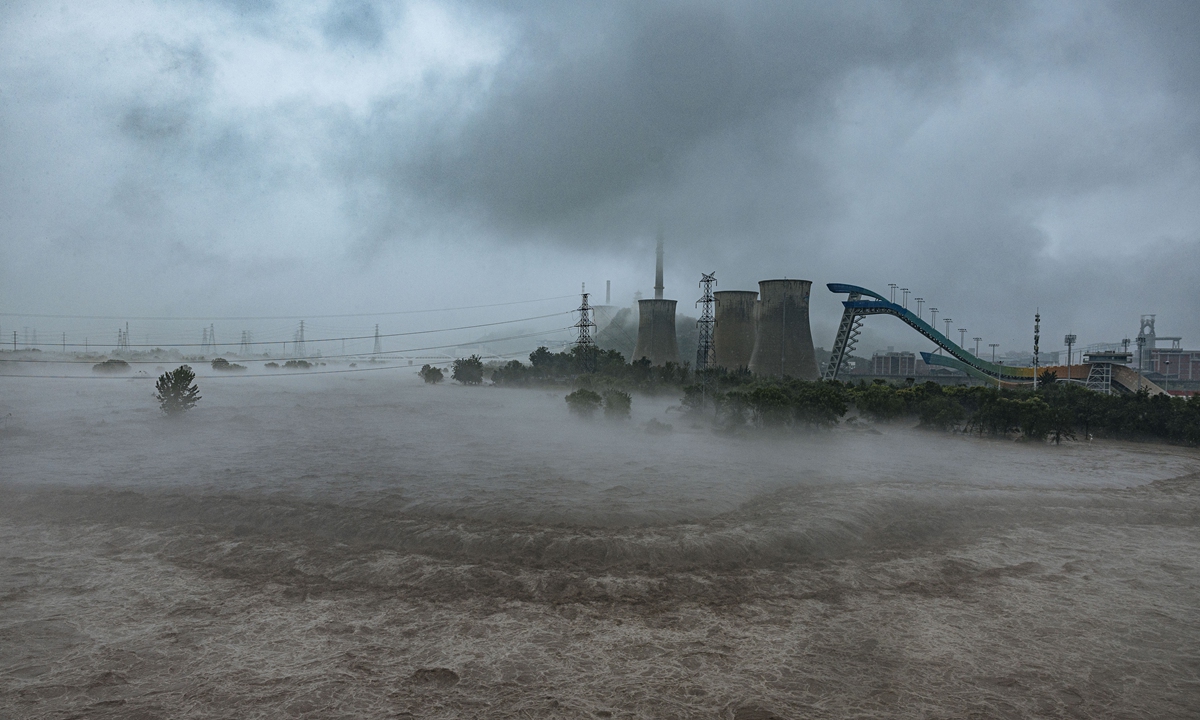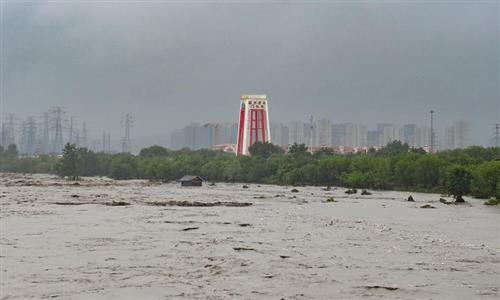
Water levels rise quickly on August 1, 2023 at Shougang Bridge over the Yongding River, fl ooding part of the Winter Olympic park, in Beijing's Shijingshan district. In the background is the Shougang Ski Jump Platform, a venue for the Beijing 2022 Winter Olympics. Photo: Li Hao/GT
The torrential rain continued to pound the Chinese capital and northern China for the fourth day and has caused extensive flooding, leading to the loss of at least 20 lives. Persistent severe rainstorms caused by the remnants of Typhoon Doksuri have lashed the region since Saturday. In response, Chinese authorities have launched massive rescue and relief efforts.
On Tuesday afternoon, Beijing authorities said that 11 people had died during rainstorms in the city, including two rescuers two who sacrificed their lives in the line of duty.
According to Beijing's flood control and drought relief headquarters, the deceased include four in Mentougou and two in Fangshan, the worst affected districts. Other fatalities include four in Changping district and one in Haidian district.
Later in the afternoon, Hebei provincial authorities confirmed that nine people have died in the downpours over the days, including four in Baoding city and five in Xingtai city.
At least 19 remain missing in Beijing and Hebei as of press time.
Chinese President Xi Jinping on Tuesday demanded all-out search and rescue for people missing or trapped by floods and geological disasters in an instruction on the work regarding flood prevention and disaster relief, Xinhua News Agency reported.
It is crucial to ensure medical treatment for the injured and provide aid and comfort to the families of the deceased, said Xi, also general secretary of the Communist Party of China Central Committee and chairman of the Central Military Commission.
The safety of the people's lives and properties as well as social stability must be ensured with the utmost efforts, Xi said.
China has earmarked 110 million yuan ($15.43 million) to support flood prevention and disaster relief work in Beijing, Tianjin and Hebei, according to the Ministry of Finance and the Ministry of Emergency Management on Tuesday.
The funds will be used to support emergency rescue work and relief work for people affected by floods, the ministries said.
Disaster and rescue
North China is experiencing a record downpour.
As of 6 am Tuesday, Beijing recorded an average precipitation of 257.9 mm, with the urban area averaging 235.1 mm. In Mentougou and Fangshan, average precipitation reached 470.2 mm and 414.6 mm, respectively.
As of Tuesday afternoon, about 45,000 people in 13 districts in the capital were severely impacted and 127,000 had been evacuated. Economic losses are being calculated, according to municipal authorities.
According to assessment, the rainfall intensity has far exceeded the level of July 21, 2012, when 79 lives were claimed across Beijing, half in Fangshan district.
The peak rainfall recorded more than 700 mm at two weather stations, while the peak rainfall in 2012 stood at 541mm.
Beijing is intensifying disaster relief efforts by employing People's Liberation Army helicopters to airdrop essential supplies and transfer stranded residents.
At the same time, water resource departments in Beijing, Tianjin and Hebei have cooperated in executing flood control, adopting measures such as pre-discharge of floodwaters and coordinating upstream and downstream to minimize the overall impact of flooding across the region.
Beijing for the first time used the Beijing Zhaitang Reservoir built in 1998 to pre-discharge floodwaters on Sunday before diverting runoff to the reservoir on Monday, maximizing the effect of flood control.
Huairou Reservoir also began flood discharge on Tuesday afternoon. In the early hours of Tuesday, its maximum downward flow was more than four times the average amount recorded in previous years.
The Global Times learned from a spokesperson for Beijing Blue Sky Rescue Team, a Chinese civil rescue squad, that team has dispatched 563 rescuers and 263 vehicles for rescue efforts in Beijing. The team has transferred more than 1,680 stranded people and 22 trapped vehicles, and rescued more than 210 endangered people in Fangshan and Mentougou Districts.
Liu Xufu, head of the public safety dive team of Blue Sky Rescue told the Global Times on Tuesday that his team arrived in Fangshan on Monday afternoon and assisted in extricating residents in a waterlogged neighborhood.
Liu said they encountered many difficulties in the rescue, including difficult weather conditions, lack of rescue supplies and physical exhaustion.
A villager in the mountainous area of Mentougou surnamed He told the Global Times that they have organized mass evacuations and spontaneous rescues over the past few days.
"From the moment it started raining, we activated the emergency plan to evacuate all villagers," he said. "But the floods came more quickly. We didn't complete the evacuation until Monday night."
The Global Times reporter at the scene saw the village was seriously affected by the flood, with the access road almost cut off and many houses washed away. He said the rescue forces that came included firefighters and rescue teams organized by the villagers themselves.
According to Hebei provincial authorities, since July 27, the province has received an average of 137.4 mm of rainfall. During the three days, the amount of water pouring in the province's waterways reached more than 400 million cubic meters, and some rivers had to cope with large volumes of water coming from Beijing. The province has recorded water level rises at 142 stations on major rivers.
As of Tuesday afternoon, Hebei Province has successively activated seven flood storage areas and completed the transfer of 847,400 people.
Zhuozhou is one of the Hebei cities most severely affected by the rain. The city government said on Sina Weibo on Tuesday that the city is suffering from black outs and water supply in some regions is cut off. It also called for rescue forces and large boats. More than 130,000 people in Zhuozhou, a city with a population of 660,000, were affected, and 83,100 were relocated.
Shao Jun, a member of the Blue Sky Rescue Team in Zhuozhou told the Global Times on Tuesday afternoon that he had received more than 300 requests for help. And he is just one of several team members who record appeals for help.
A video showed that the parking lot of a residential building in Zhuozhou had collapsed while rainwater continued to pour in, flooding some of the lower floors. Residents calling for help said the neighborhood has lost water and power, and that they have been trapped for 20 hours.
Xingtai is another Hebei city hit by heavy rain. A Xingtai resident surnamed Liu told the Global Times that almost all of the crop fields near his village were flooded.
Warnings effective
According to weather forecasts, the rain in Beijing, Tianjin and Hebei will significantly weaken from 8 am Tuesday.
to 8 am Wednesday. However, there will still be moderate to heavy rainfall in west-central and northern Hebei along the mountains, and in Beijing, northern Tianjin, and northern and western Henan Province. Some areas will experience short bursts of heavy precipitation.
At the same time, Beijing Municipal Meteorological Observatory warned on Tuesday morning that the risk of secondary disasters such as small and medium-sized river floods, flash floods and geological disasters induced by heavy precipitation in mountainous and shallow mountainous areas remains high.
A longtime Mentougou resident surnamed Lu told the Global Times on Tuesday that the rain had almost stopped.
"But since noon on Monday, water supply has been off in most parts of Mentougou," he said. "Supermarkets have also run out of water. Residents are lining up in their neighborhoods to get water."
Although Beijing and the neighboring areas had put in place contingency plans before the storm, the duration and volume of the rain far exceeded expectations, referring to the huge impact it caused, Ma Jun, director of the Beijing-based Institute of Public and Environmental Affairs, told the Global Times.
Beijing recorded less than 500 mm of total precipitation in a full year in 2022. However, over the past three days, nearly 500 mm of rain fell in the districts of Mentougou and Fangshan, Ma noted.
"When a year's worth of rain falls in three days, the soil of the mountains in the mountainous areas is almost saturated, creating very serious flash floods and mudslides," he said.
Beijing sent out timely forecasts and warnings ahead of the storm and was resolute in stopping non-essential activities and closing tourist attractions, measures that largely prevented further casualties, analysts noted.


